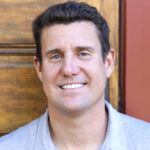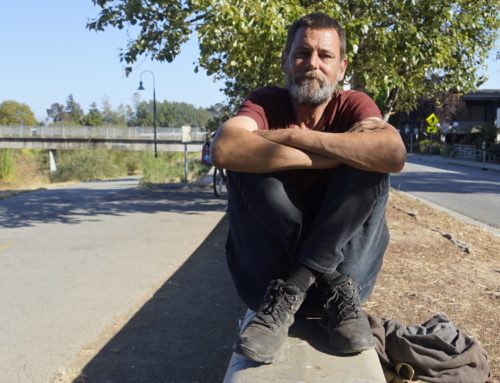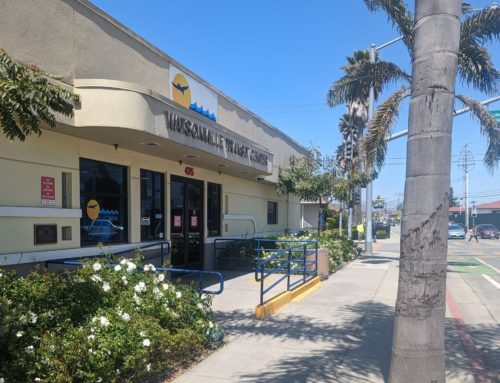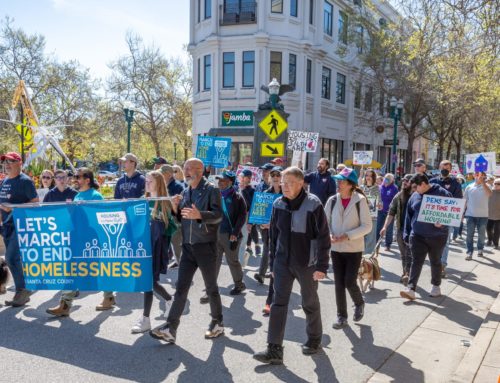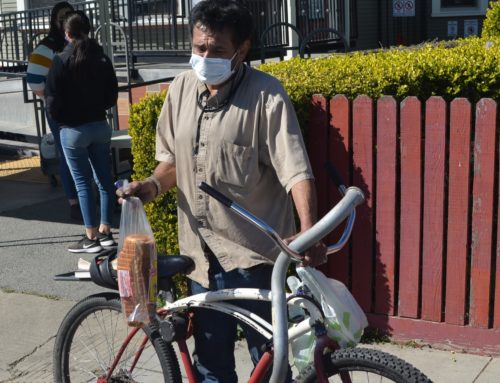Our work on the People’s Agenda continues. Candidates for the District 1 supervisor race discuss plans for homelessness, the rail corridor, traffic, housing and jobs. We hear from incumbent John Leopold and challengers Manu Koenig, Mark Esquibel and Benjamin Cogan.
If you’re a voter in Live Oak, Pleasure Point, Soquel, western Capitola or the Santa Cruz Mountains north of Soquel, you’ll vote on this race. But even if you don’t live in the district, this race still matters to you. The decisions of the board of supervisors affect the entire county.
Do you live in District 1? You’ll vote in this race.

Editor’s note: Transcripts are usually only for members, but we’re making our “Vote March 3” transcripts available to everyone. We hope this series will encourage more people to get informed about the March 3 local elections.
Listen to the rest of our “Vote March 3” elections series.
- Part 1: Voting in Santa Cruz County 101 (Jan. 8, 2020)
- Part 2: The People’s Agenda (Jan. 30, 2020)
- Part 3: The District 2 supervisor race (Feb. 3, 2020)
- Part 4: The District 1 supervisor race (Feb. 6, 2020)
- Part 5: Santa Cruz City Council recall, Drew Glover’s seat (Feb. 9, 2020)
- Part 6: Santa Cruz City Council recall, Chris Krohn’s seat (Feb. 10, 2020)
TRANSCRIPT
[MUSIC]
KARA MEYBERG GUZMAN: This episode is sponsored by UC Santa Cruz. UC Santa Cruz tells its story every other week in its StoryCruz podcast. Listen to conversations about UC Santa Cruz news, research, breakthroughs, people and events. Find StoryCruz on Stitcher, iTunes, and Google Play.
[MUSIC FADES OUT]
KMG: I’m Kara Meyberg Guzman.
STEPHEN BAXTER: And I’m Stephen Baxter.
KMG: Welcome to Santa Cruz Local.
This is Part 4 of our elections series “Vote March 3.”
Today’s episode: The district 1 supervisors race.
If you’re a voter in Live Oak, Pleasure Point, western Capitola, Soquel, or the Santa Cruz Mountains north of Soquel, you’ll vote on this race.
But even if you don’t live in those areas, this race matters to you. The board of supervisors makes decisions that affects everybody in the county.
SB: The county board of supervisors tackles questions like: Where do we put new housing? How do we fix traffic on Highway 1? What do we do with money that’s meant to fix homelessness?
So if those issues are important to you, you should care who gets this seat.
KMG: Alright, Stephen, tell us about the candidates.
SB: Well, there are six candidates. The incumbent is John Leopold. The challengers are Manu Koenig, Mark Esquibel, Benjamin Cogan, Betsy Riker and Donald Kreutz.
Here’s John Leopold. He’s 54. I talked to him at his house in Live Oak.
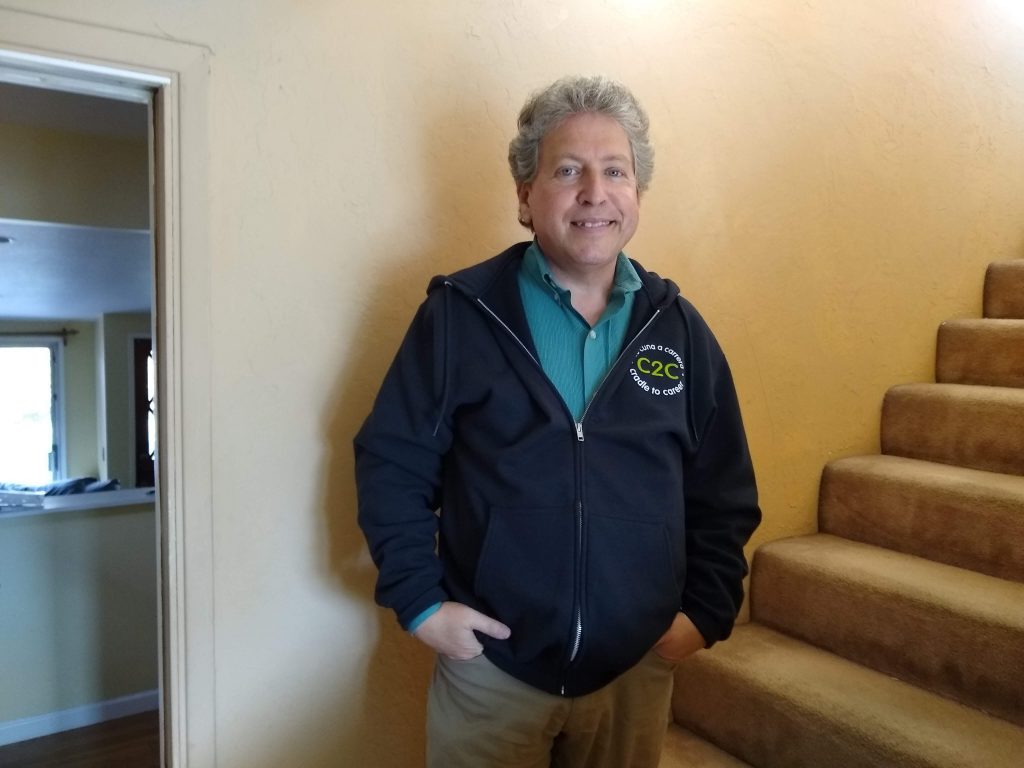
JOHN LEOPOLD: You know, I’ve lived in Live Oak for the past 26 years, I’ve raised my family here, gotten involved doing everything from being involved with nonprofits, serving as a little league coach, serving on the Cabrillo College board.
And I’ve been county supervisor since 2009. And all the work I’ve done has been working with the community to help advance our common goals.
We have great opportunity – and some challenges – great opportunities in thinking differently about the kind of housing we develop, the kind of access to medical services that we have, the kind of facilities for young people, both recreationally and educationally. And we are looking at new policies to help us deal with the changing nature of the climate, whether it be sea level rise, or the risk of wildfires in our rural parts of our community.
So it’s – there’s a lot going on, and I have worked very hard to be out in the community, listening to people, working with them, and coming up with solutions that work for a lot of people.
STEPHEN BAXTER: And just on a personal note, what’s a fun fact about you? Do you have any hobbies?
LEOPOLD: Well, I usually tell people that I served 10 years on the board of the Rex Foundation, which was the philanthropic foundation started by Grateful Dead. I saw the Grateful Dead 250 times.
SB: Manu Koenig is the second candidate. He’s 34 and he’s an environmental consultant.
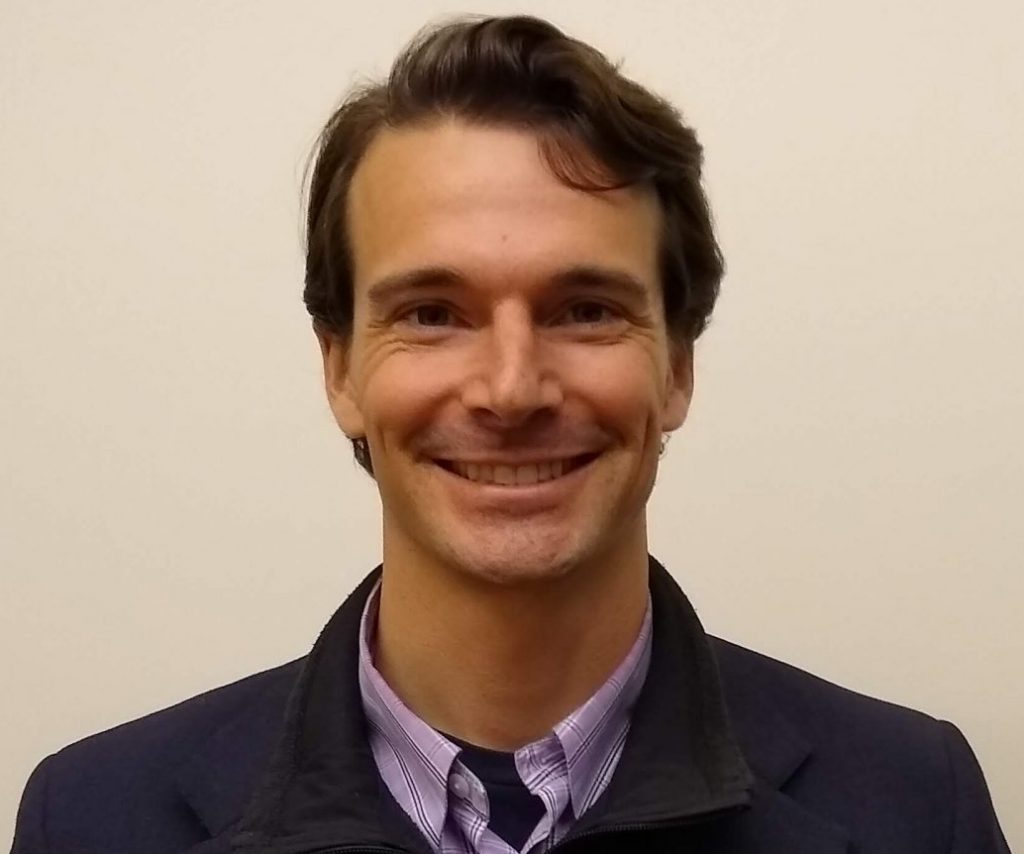
MANU KOENIG: I grew up here, but lived in San Francisco, Berlin, L.A. – and have realized this is really the greatest spot on Earth because we have a head as bright as Silicon Valley and a heart as big as the ocean. So I think that we have a lot of potential to solve some very big problems right here in Santa Cruz. And I strongly believe in the mantra of thinking globally but acting locally.
BAXTER: And what’s a fun fact about you that people might not know you, have any hobbies or anything?
KOENIG: I like to climb. I’m an avid member of the Pacific Edge climbing gym. And my name means “bird.” Manu means “bird” in Polynesian.
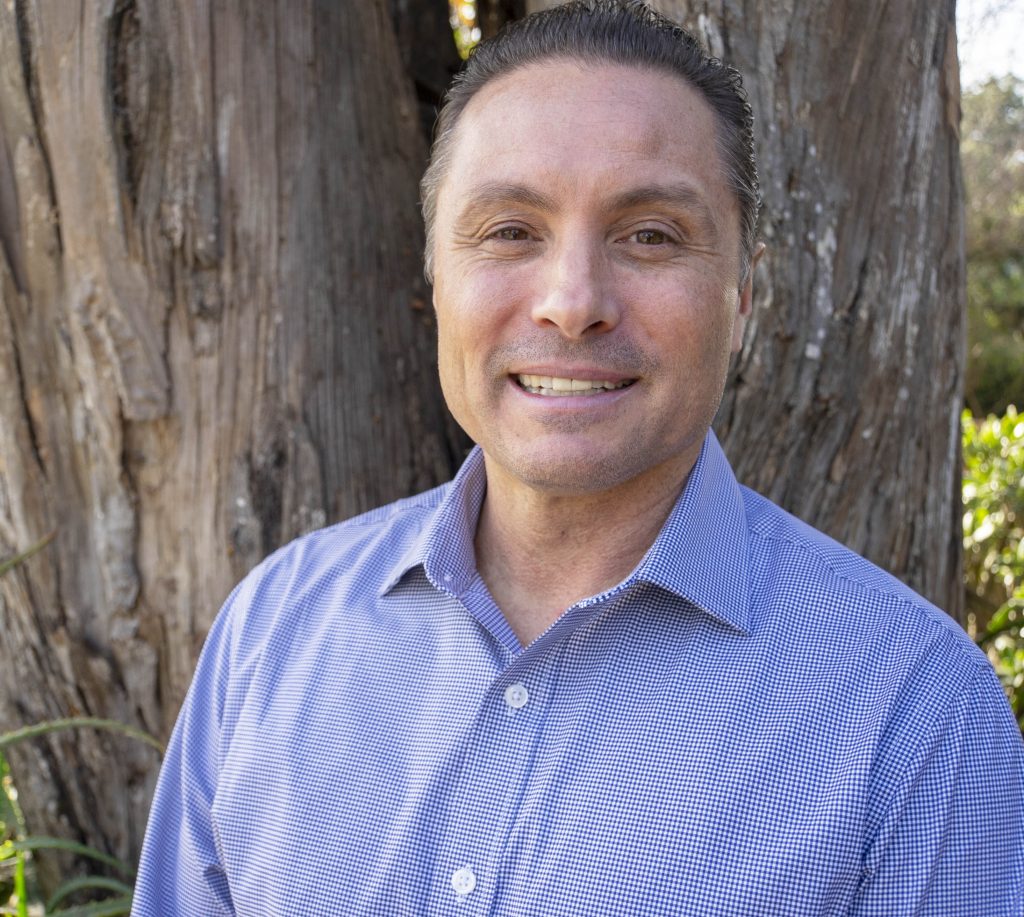
SB: The third candidate is Mark Esquibel. He’s 47. His most recent job was as an environmental health and safety manager for a petroleum pipeline company. We asked him what local issues affect you that made you want to run for office.
ESQUIBEL: The highway affects me every day. The health and safety with the needle exchange program affects me every day. Crime affects me every day – how I drive around.
I used to just leave bags and in the car. I mean, I don’t do that anymore. Like, my car’s, you know, stripped down because if you have any piece of property or equipment in there, they’re going to smash your window and they’re going to they’re going to take it.
A fun fact they might not know? I surf. I love surfing. This is a surfing community. It relaxes me.
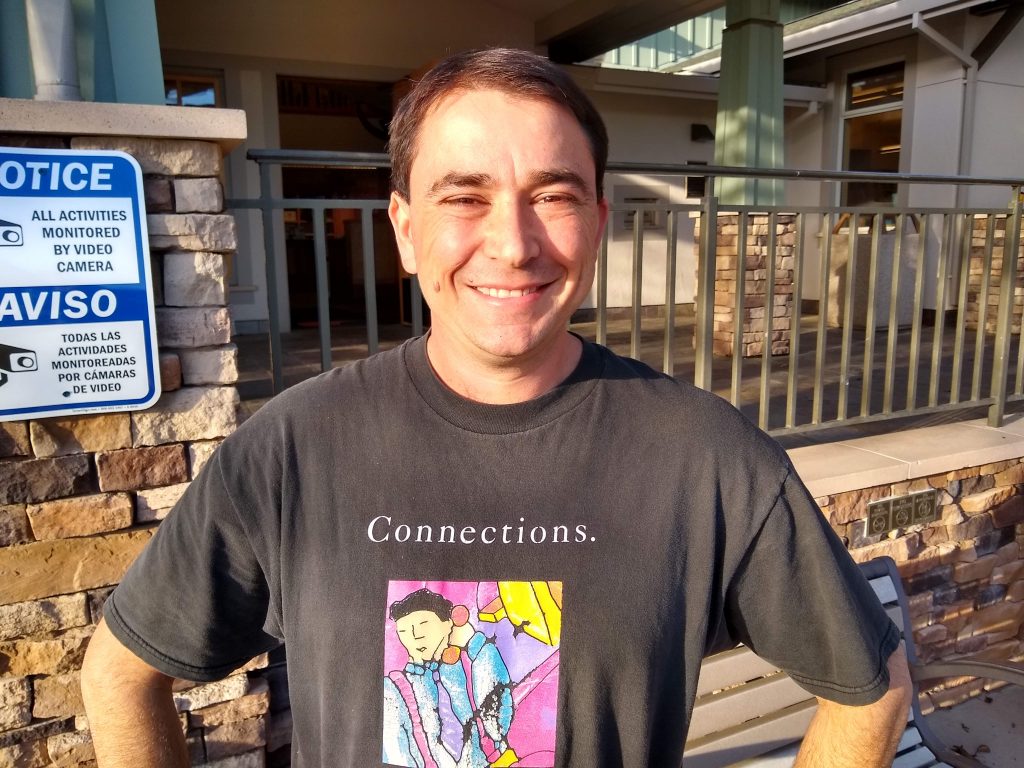
SB: The next candidate is Benjamin Cogan. He’s 36. He’s self-employed and he has been a mechanic.
BENJAMIN COGAN: So my vision for 2020 moving forward is to reinstate the Citizens Appeals board. Really take a look at all the fees and regulations the planning department has and see if we can lower them and reduce the regulations to make it easier for homeowners to build on their property and provide housing.
A fun fact about me … Boy Scout, Eagle Scout Troop 37, Redding. And a lot of camping, whitewater rafting and all that. I can tie some knots.
SB: The last two candidates are Betsy Riker and Donald Kreutz. Riker did not respond to our requests for an interview. Kreutz didn’t respond in time for us to interview him. He also said he was working so much that he couldn’t attend the two candidate forums.
Riker and Kreutz have raised no money for their campaigns, according to the most recent campaign filings.
KMG: Can you remind our listeners about our goal with these candidate interviews?
SB: Sure. We talked about this in our previous episodes. Over the last few weeks we interviewed more than 200 people across the county. We wanted to hear people’s priorities about the upcoming election.
Top themes that came out of District 1 were: homelessness, housing, the environment, traffic, the rail corridor and jobs. We came up with a list of questions for the candidates based on what we heard.
KMG: Alright, let’s get to it. So what was the first question?
SB: Well, I asked everybody the same question. And you’re going to hear their responses in the order that we just did. The question is: Homelessness is a top concern among voters in your district. They see a lack of progress. What is the problem with the way the county has been handling homelessness? What policy would you push forth with new state money that’s coming to address homelessness?
Here’s John Leopold.
LEOPOLD: Well, we’ve been pursuing an effort to enact a three-part strategy, which is: increasing rent subsidies to keep people in their houses. Because we know time after time on the homeless census, nearly 70% of all the people who are homeless on our streets first became homeless after living here in Santa Cruz in a house. So, keeping people in their homes is our — is a strong strategy. So we’ve greatly increased rent subsidies.
We’re increasing shelter capacity, this year we’ve increased it by 30%. We’re working with both the City of Watsonville and Santa Cruz, about building navigation centers. That will be a great expansion in number of shelter space, and we’re also working on interim solutions that get us there to the permanent facilities.
And lastly, we are thinking about using — doing development differently and using our own land to build housing. We just approved a 57-unit, family affordable housing project on Capitola Road with new health centers. We’ve dedicated park land here in the first district for Habitat for Humanity.
And we’re also thinking about doing development differently. Tiny Homes, small houses, greater density along our transit corridors. So we could have apartments, condominiums, townhouses to have a diversity of housing stock to be able to better meet the needs of people in the future.
SB: Here’s Manu Koenig. Same question. What’s the problem with the way the county has been handling homelessness? And what policy would you push forth with new state money?
KOENIG: The biggest problem is people don’t have homes and we’re not providing a place for them. Right? So, last year, we got 11 million dollars, roughly in emergency aid from the state to combat homelessness, and we didn’t build a single home. So fundamentally, we have to create places for people, I think this involves both some kind of transitional encampment where, you know, we can ask people to go in the evening instead of being on the river levee and then from there we can look to more permanent solutions. I really liked the model of the Tiny House Village. Austin, Texas is doing this. It’s called Community First Village.
And it’s great because it really does three things. First, if it provides housing, which is important for anyone to heal and get their life back together, I firmly believe housing is health care. Second, it provides community, friendship, and, you know, just you can build a sense of yourself through your friends. And third, it provides work. So you actually have to pay $250 a month to live in this community and you can earn that on site either in the kitchen and the garden or the machine shop even.
And we’ve actually seen here in Santa Cruz that work is an essential part of the solution. The most successful programs here are the Homeless Garden Project and the Downtown Streets Team.
SB: I asked him where those villages could go.
KOENIG: Yeah, two things. First of all, I think that probably every district is going to have to select a location and maybe that’ll be a discussion within each district. I mean, it would just be unfair to say, hey, they’re all going to North County, they’re all going to South County or all Mid-County. And then I think that has to be a community conversation.
You know, the county does have 1200 plus acres of vacant land to look at. So, there’s some options there and maybe we should acquire a new parcel as well.
SB: Here’s Mark Esquibel. Same question. What’s the problem with the way the county has been handling homelessness, and what would you do to address it?
ESQUIBEL: Sadly, it’s – it’s been what’s described as a leaf-blower mentality. So, you come into town you get your free services, you park your tent like I just saw out here on Soquel bridge, and then we blow you over to Live Oak.
Think of it as, as kind of like a triage. If you take — we’ve got 5 — over 500 homeless how we’re going to fix this. Okay, well, you chip away you started, you start at 100. Napa just brought in 100 pods for their homeless problem. So they’re giving them home.
Thirty of those people, if you do the breakdown are just down on their luck. They just they just need some help. Sometimes you’ve seen them they’ve run out of gas. So you help those 30 people. The other 30: It’s a mental health crisis. Sometimes they’re not, you know getting the right medication or they’re veterans and they got PTSD.
So you have to deal and take those resources and deal with it properly.
SB: Here’s Benjamin Cogan.
COGAN: So there’s a lot of volunteers and help already out there: Food Not Bombs, the Warming Center and a couple other shelters. But it’s — it’s not attractive to people that are homeless because it’s still — there’s rules and requirements and stuff to be there like at 6 p.m. and stuff like that.
But for a lot of people, if they just had a place where they could park their RV or live in their car and maybe pay a minute amount with a public restroom, that would solve some of the homeless problem — have a place to go or they could like pitch a tent and have a little cabin.
And so, have like more little spots, designate spots where people can go and sign a little waiver, like a lease agreement that they won’t be noisy after 10 they won’t do drugs or drink on the premises.
And for those that you know, are battling with drug addiction or alcoholism, you know, having a place with medical staff — people that have helped, therapy and like a designated spot where they can go get the treatments they need, or the support or supervision they need, would really help out.
SB: Second question. Many voters in District 1 listed traffic as a daily problem. What specific projects would you push to address traffic?
John Leopold.
LEOPOLD: We’re looking at improvements on all of our main travel corridors, which is Soquel Drive, where we’re doing a lot of effort, especially here in the First District to think differently about the kind of ways in which people move around, especially as we see development opportunities happen.
We have put money into the highway. So we’re going to be adding the auxiliary lane next between Soquel and 41st Avenue that will have a big effect on the First District. And we’re looking at the Rail Corridor, we just did the groundbreaking on the first leg of the Rail Trail, it’ll probably be out here in Live Oak by 2025. And we’re trying to think about what kind of transit we can put on that corridor, whether it be train, bus, or some other fixed guideway system.
I’ve also worked very hard to increase bus service and stabilize the Metro after many years of financial instability. And now we’re in the process of being able to add back service rather than just subtract service.
SB: Here’s Manu Koenig. Same question. What specific projects would you push to address traffic?
KOENIG: Providing safe by bike infrastructure is just the safest cheapest thing we could do. I would start by building as many protected bike lanes as possible.
San Jose actually is a great model for this. They built 10 miles of protected bike lanes in the last year for one and a half million dollars using a quick-build approach. And they just made sure that every time they resurface the streets, they’re putting in protected bike lanes or improving the bike infrastructure in some way. So I would absolutely make that a priority.
Then the next thing we can do is improve the bus system. Every new development should be helping to fund the bus and increasing frequency along major routes. So buses are best or — really true of all transit — if it runs every 10 minutes or less than you really see an increase in ridership and I think we need to make sure that we have those kind of short headways on major routes here in the county.
SB: Here’s Mark Esquibel on traffic.
ESQUIBEL: First off, I’d scrap the Rail Project. We don’t need $750 million for a rail – 32-mile rail from the Westside to Watsonville. We need the widening of a highway. We don’t need in the next five years a temporary Band-aid for a decade-long problem.
We’re going to get two auxiliary lanes out of that $750 million — which, by the way, is going to be a billion when we’re done so, their estimate is 750. You need to widen the highway you need to build a trail, get some e-bikes traveling out on that trail, rip the rail up and build the trail.
SB: A note here. The projected price tag for rail service from the Westside to Pajaro is actually closer to $475 million. That’s according to the Unified Corridor Investment Study prepared for the Santa Cruz County Regional Transportation Commission in 2019.
Here’s Benjamin Cogan. Same question: what to do about traffic?
COGAN: There’s congestion on Highway 1 with all the on-ramps and maybe doing something with the on-ramps there’s longer merge times or lanes or adding a lane there.
I don’t think adding a whole lane to the whole length of Highway 1 is, is necessary at the moment.
Also I want to make sure we don’t go into a big budget deficit with all the building and, and basically figuring out ways where not everyone will be on the road at 7 a.m. and 5 p.m., so see if we can get times to differentiate between jobs or if there’s, you know, government programs that are in Watsonville, people commuting, if they can move it so that it’s less commute, things like that.
When we are all watching and engaged in our public institutions, our needs are addressed, democracy works better and our community is stronger.
Santa Cruz Local’s vision
SB: Next question. We heard from some voters last month what they wanted for the rail corridor. We asked the candidates to explain their stances on rail-trail vs. trail only plans.
Here’s John Leopold.
LEOPOLD: Well, you know, after 20 years of talking about the rail corridor, when I came into office, I led the effort to actually purchase it. And that – that was not a small task. It required rallying people here in the community. It required traveling the state to talk to California Transportation Commissioners. And it required convincing Caltrans and other agencies to give us the money to purchase that line.
The concerns in Sacramento when we were seeking that money was that we were going to take the money rip up the line and just put a bike path in, and they said this is inner-city rail money.
And we made a commitment – the Regional Transportation Commission – made a commitment that we were going to make an honest effort at a rail line. We have done a lot of studies to take a look at this, and after the Unified Corridor Study, we agree that we would do an alternative analysis.
Some of those “trail-only” people actually recommended that we take the Metro suggestion to do this alternative analysis, which is trying to figure out what kind of transit, high-capacity transit could be on that line as another way to move people through this county.
And so, I believe that when you have public infrastructure, you have to have a vision about how you’re going to connect the community together. And it’s — it can be small minds that say, we can only use it for one thing. There’s no other transportation corridor that we can use. If we give it up, it’s gone. And so, doing this dual path of a 12-foot path at least and some kind of transit really makes sense for our community.
SB: This is a key difference between John Leopold and the rest of the candidates. The rest of the candidates — spoiler alert— are actually against the idea of a train. Manu Koenig, who you’ll hear from in a second, was executive director of Greenway.
Greenway is the group that’s leading the effort for a trail-only plan. Koenig left Greenway in October, around the time he began campaigning for this post.
I asked Koenig why he’s against a train.
KOENIG: The first is that it’s one track, not two. And that limits frequency significantly. There’s only two places for the trains to pass each other, which means you can only run a train every 30 minutes. And that is just doomed to be not a robust enough system for people to actually use.
And you can think about this in your own experience. You go down to the transit platform, train or bus. If it says next bus coming in five minutes, great. If it says next bus coming in 16 minutes or 25 minutes, you might think about using a different mode.
Then the other big problem is the funding. Right? We would need to pass a new local sales tax measure or a parcel tax in order to fund to train. And, you know, it may be true that there’s, say, a billion dollars out there in state funding for rail. Even so, we would need matching local funds to cover operational costs.
SB: You’ve already heard from Esquibel why he’s against the train. Here’s Benjamin Cogan.
COGAN: Well I’m definitely not for the train. I think building a train would be – I’d rather solve the homeless crisis than the train and I’m not sure it’s going to have much use or how much the cost of tickets would be or the environmental impact.
The rail trail sounds like something people are wanting and need and probably can be done much more cheaper and allow people to ride their bikes or have access.
SB: Next question. We interviewed more than 200 people. Many said that they wanted Santa Cruz County to be more of a leader on environmental policy. Some of the things we heard were more bike lanes, composting programs and better public transit. What are two environmental policies you will push to get on the county supervisors agenda in the next year?
For Leopold, it’s about limiting plastics.
LEOPOLD: We’re looking at things like micro-fiber pollution and other ways in which plastic enters our waste stream. It’s been said that we each eat about a credit card’s worth of plastic each month. Because the way it’s infiltrated our food system.
We need to do two things: we need to stop this waste from entering the food chain and we need to work incredibly hard about producer responsibility, that it’s – that we need to stop creating the plastic and not have consumers be responsible for taking care of the trash created by corporations.
SB: Here’s Manu Koenig. Koenig spoke about housing and transportation as an environmental policy.
KOENIG: Sixty percent of our carbon emissions come from transportation. And we have a plan. It’s called the Sustainable Santa Cruz plan to build more walkable communities and to fund better transit. And yet, today we’re ignoring that plan.
At our first opportunity to really make progress on 41st Avenue and Soquel Drive, we downzoned to put in a car dealership instead of up-zoning to create the mixed-use activity center that the plan called for.
So, I would prioritize implementing the Sustainable Santa Cruz plan and more mixed-use development that funds transit.
SB: Here’s Mark Esquibel. The question again: What are two environmental policies you will push to get on the county supervisors agenda in the next year?
ESQUIBEL: I’m sure they’re going to want to drill. They’re always want to drill in our bay. I would oppose drilling in the bay, again, I’m – I’m a surfer.
And then just the, the mental health crisis. It’s a, it’s a safety issue. We started the needle program as a safety and health program. We got told by our supervisor to check our cynicism at the door, and now it’s become an actual safety and health problem. It’s become a hazmat problem.
The Ross Camp was a hazmat problem.
So if we don’t put the needle exchange program, you know, under wraps, and we just allow needles to be strung everywhere through our community, you’re – you’re now directly impacting the people you said you were going to protect.
SB: Here’s Benjamin Cogan on environmental issues.
COGAN: Well, definitely to ban plastics or to prevent plastics or have alternatives like things made out of pistachios or shells or something like that, and give incentives for reusable cups, forks and mess kits and stuff like that.
And with all the trees being cutting down, trees being important to our atmosphere and our breathing and they’re just the tree. I love trees. Try and, you know, limit the amount of trees PG&E is cutting down and make sure we have property owners’ consent and they’re fully informed of whatever the plans they have.
SB: One of the most common concerns we heard was housing. Candidates often say they’re for affordable housing, but we want to know what that means. What types of specific developments would you support and where could they be in Santa Cruz County?
Here’s John Leopold.
LEOPOLD: I think that the – the conversation we had with the community around the Sustainable Santa Cruz County Plan was to look at increases in densities along our transit corridors and well-designed three-story buildings that could, that could provide a lot of housing for our needs in the community.
We’ve – we’ve approved the first one on Portola, and I expect we’ll see lots more on Soquel Drive, especially after we finished the environmental work on the Sustainable Santa Cruz County Plan.
SB: Here’s Manu Koenig. Same question. What types of specific housing developments would you support, and where could they be in Santa Cruz County?
KOENIG: Ultimately, the idea of building near transit hubs is a good one, as I’ve said, I mean, it’s the only way that we can build our way out of the predicament that we’re in today.
You’re kind of asking the NIMBY question, right, of like, it always comes down to “well, I like housing but not in my backyard.” I think that actually it’s more about design than density.
And so I would actively work with new proposals and projects between both developers and neighbors about – to provide – create attractive projects. You know, I think ones with setbacks, ones with greenwalls. I think if we see more community space, etc, that neighbors might actually be able to get excited about those projects.
You know, none of us want to see Santa Cruz turn into San Jose. We don’t want the brown boring sheer, four-story walls. It doesn’t have to be that way. So, that would be my approach, is, you know, first let’s work actively on the design with neighbors. And then ultimately, we might codify that in the zoning code itself and the design guidelines so that those are the kind of projects we see in the future.
SB: Here’s Mark Esquibel. Again, the question was, what types of specific housing developments would you support and where could they be in the county?
ESQUIBEL: Right now, I think you have a, it’s a three-story restriction. You might have to revisit that and say, if we’re restricted to three stories, for instance, the Rebele property for the homeless. If that thing was six stories, we could double the capacity. And so that’s another – address the solution specifically. So maybe we need, you know, some, some looser restrictions on, on building so that we can actually address the issue.
You’re going to get 600 units at the Capitola Mall. I’m sure that took a lot of time and processing. And so, each, each county and each supervisor has to look at the right solution for the community.
SB: Here’s Benjamin Cogan.
COGAN: This is kind of along the same lines of making it easier for homeowners to build on their properties so they can rent to people that need housing. That money stays in their pocket. They can help pay all their taxes, fees and regulations, parcel tax, as well as have more spending cash in Santa Cruz.
SB: Last topic. Many of you we interviewed said you wanted higher wages and more jobs in Santa Cruz County. Many of you said you have friends or family leaving the county because they can’t find those kinds of jobs.
I spoke to John Leopold about this in December. I asked him, what can the county do about jobs?
LEOPOLD: Well, I think we’ve done actually a bunch of things. I mean, the legal cannabis industry has created an amazing number of jobs. Better than minimum-wage jobs, across a wide variety of employment sectors.
When we had an EIR, a draft EIR, that said if we had a well-regulated industry, we might hve 5,000 to 7,000 jobs. I’m not sure we’ll have that many, but we might have a couple thousand jobs in cannabis. And that generates also a lot of tax income.
Bringing a Kaiser facility in here, a 150,000 square-foot facility, that’s important because you could be a local high school student who goes to Cabrillo for two years, come out to get a job that pays $60,000 to $80,000 as a nurse or a radiologic technician.
So, healthcare is a big employment driver. In fact, it’s one of the four pillars of the Santa Cruz County economy. It’s one of the best paying. And it’s one that you can actually stay in Santa Cruz, get your schooling and get your job altogether.
So, when we see an expansion of the Santa Cruz Community Health Centers, East Cliff Family Health Cetner on Capitola Road, those are going to be jobs. Dientes? Those are jobs. Kaiser? Those are jobs. Dominican and Sutter and what their plans are? Those will be jobs and those will be good jobs.
We’ve also focused a lot on small business, because here in Santa Cruz, 82% of the businesses have nine employees or less. And what can we do to help those businesses? Because some of them will grow to be bigger businesses. How can we support those businesses? We now have an economic development office that focuses on those folks as well.
SB: Here’s what we asked Manu Koenig. Many people we spoke to said they have friends or family leaving Santa Cruz County because of the high cost of living. Many said they want more jobs and higher wages. Do you agree, and how would you address this need?
KOENIG: Yeah, first, I want to commiserate with the fact that people moving away. You know, having been born and raised in the community, it’s really hard to keep living here because of the reasons you mentioned, and nothing is destroying our community faster than the high cost of housing and people who grew up here not being able to live here.
So, as far as providing good jobs. You know, the Santa Cruz New Tech Meetup is one of the most vibrant meetups in the whole county. Most vibrant events in the whole county and I know you know this because I’ve seen you there, Stephen.
You know, it’s often 200-plus people, there’s a lot of excitement in the room. And there are some really creative and compassionate people in Santa Cruz. This is not people coming from over the hill here. This is who was already here and who choose to call Santa Cruz home.
So, we just need to provide the capacity for them to do their thing, start great companies here in Santa Cruz, because it’s happening.
So, it comes down to providing more commercial space. And as outlined in the Sustainable Santa Cruz plan, two of the biggest opportunities sites are in the First District. It’s the Soquel Research Center, which is kind of near 41st and Soquel. And the other one is the Ledyard Distribution center off 17th and Brommer. Those are both big kind of industrial, industrially zoned areas that could be rezoned for mixed use, and more commercial office space. And I think if we create the office space there we’ll see many businesses started here and stay here because of Santa Cruz local creative culture.
SB: Here’s Mark Esquibel on jobs. It was a follow-up question we asked on the phone.
ESQUIBEL: You have a bunch of people commuting. So maybe trying to get some of the companies to open up satellite places. We’ve got such big telecom hubs and thousands of people are commuting over there every day.
And I’ve heard people say, ‘Oh, they won’t come over here because we don’t have enough, you know, broadband speed.’ But that’s being worked on.
It’s kind of all tied together. Homeless, stagnant wages, big business over the hill, not as much business here, and then the homeless affecting the businesses that are here because of the mental health crisis.
SB: Here’s Benjamin Cogan, also on jobs.
COGAN: I’m totally for better-paying jobs, and you know, I want businesses to thrive and all that, and welcome new ideas and new businesses. And, but you know, at the same time, I don’t want to see Santa Cruz totally become corporations.
So like, how do we give the power back to the local people, so they can thrive and they can run their businesses? And so, just making things easier for people to even start up or have startup businesses is critical to the job boom movement.
KMG: Stephen, what stuck out to you as the differences between the candidates?
SB: Well, one big difference is that the incumbent, John Leopold, is the only candidate who wants to keep the rail line and have a potential train next to the trail on that rail corridor.
Manu Koenig, one of the challengers — his group Greenway, we should say, sued the Regional Transportation Commission because the commission entered into an agreement with a rail company that wanted to use that rail line. They lost that lawsuit last year.
KMG: So Stephen, we heard from our interviews in the community that housing is a top concern. What else did you learn about the candidates’ stances on housing?
SB: Well, the incumbent, John Leopold, and one of the challengers Manu Koenig, are actually pretty close in their stances on housing. They both want to follow the Sustainable Santa Cruz County plan. A big part of that plan is to put more multifamily housing near transit.
One of Manu Koenig’s criticisms of John Leopold is that Leopold may not have upheld the spirit of the Sustainable Santa Cruz plan when he voted to approve a new Nissan dealership that’s at 41st Avenue and Soquel. That land had basically sat empty for more than 20 years. And nobody had come forward to build anything, housing or any mixed use or anything else.
Koening’s criticism was basically that more work should have been done to try to build something other than a car dealership.
One thing we didn’t include here was that Leopold really talked about his record of getting a lot of housing built in District 1, places like Live Oak and Pleasure Point. That area has really had more multifamily housing built than pretty much all of the other unincorporated areas of the county.
For example, the board has approved 31 units of new housing on Portola, and then a 57-unit complex on Capitola Road. There’s also a project in the works on 7th and Brommer. That should lead to several dozen new units.
KMG: Yeah, keep in mind, though, that the county is still short on its housing production goals, much like the rest of the state. These goals are known as the RHNA goals. They’re determined by the state and then handed down to the regions to allocate to the local jurisdictions.
For the unincorporated county, it was given eight years to build 1,300 units. The deadline’s 2023. And so far, the county has issued permits for only about a third of that goal.
SB: So there’s still a ways to go. Another note on John Leopold and his housing record. District 1, that he represents, has more than 30 mobile home parks. He put forth a proposal to the county board of supervisors in the last few months that basically said that if a mobile home park owner wants to close that park, they have to find new housing for all the people that are displaced. So, the state is also working on a similar law, but it’s been enacted in the county already.
KMG: Alright, let’s look at campaign finance. Looking at lists of donors can give you an idea of how much support candidates have and also who and what kinds of groups support them.
So, the only candidates that have raised any money so far are John Leopold and Manu Koenig. Manu Koenig has raised about $32,000 since January of last year. His donors include several outspoken trail-only proponents.
For example, Greenway, the nonprofit that Koenig previously headed, donated $1,000 to his campaign. Several of those board members also donated. Bud Colligan, $500. Miles Reiter, CEO of Driscoll’s, $500. And Will Mayall, $100. Brian Peoples, who you may know as the head of the advocacy group Trail Now! also donated $500.
SB: John Leopold raised about $75,000 since January of last year. I’ll just highlight three groups in here.
There were two elected leaders who donated: Justin Cummings, Mayor of Santa Cruz, $200. Katherine Beiers, [a former mayor] who’s a candidate for Santa Cruz City Council, $100.
There was a fair amount of cannabis-related businesses. However, the total money that they donated is about 2% of his total war chest here. So some of the names for instance, are the owner of KindPeoples cannabis dispensary, $500. The CEO of Fog City Farms, a cannabis cultivator, $400. Santa Cruz Naturals, $400. Santa Cruz Canna Farms, $250.
And then the third group that I thought was of interest is the Building and Construction Trades Council of Monterey and Santa Cruz County donated $500. And the National Union of Healthcare Workers, also $500.
[MUSIC]
KMG: Sign up for our newsletter. We update you on what’s going on in local government. Sign up is at santacruzlocal.org.
Our journalism is free for everybody in Santa Cruz County. We’re supported by our members. Thank you to our Guardian-level members, Elizabeth and David Doolin, Patrick Reilly, Chris Neklason and the Kelley family.
If you find our work valuable sign up for a membership. Membership signup is at santacruzlocal.org/membership.
Thanks to Trimpot for the theme music. Look for our next episode in our election series in the next few days.
I’m Kara Meyberg Guzman.
SB: And I’m Stephen Baxter.
KMG: Thanks for listening to Santa Cruz Local.
Stephen Baxter is a co-founder and editor of Santa Cruz Local. He covers Santa Cruz County government.
Kara Meyberg Guzman is the CEO and co-founder of Santa Cruz Local. Prior to Santa Cruz Local, she served as the Santa Cruz Sentinel’s managing editor. She has a biology degree from Stanford University and lives in Santa Cruz.

